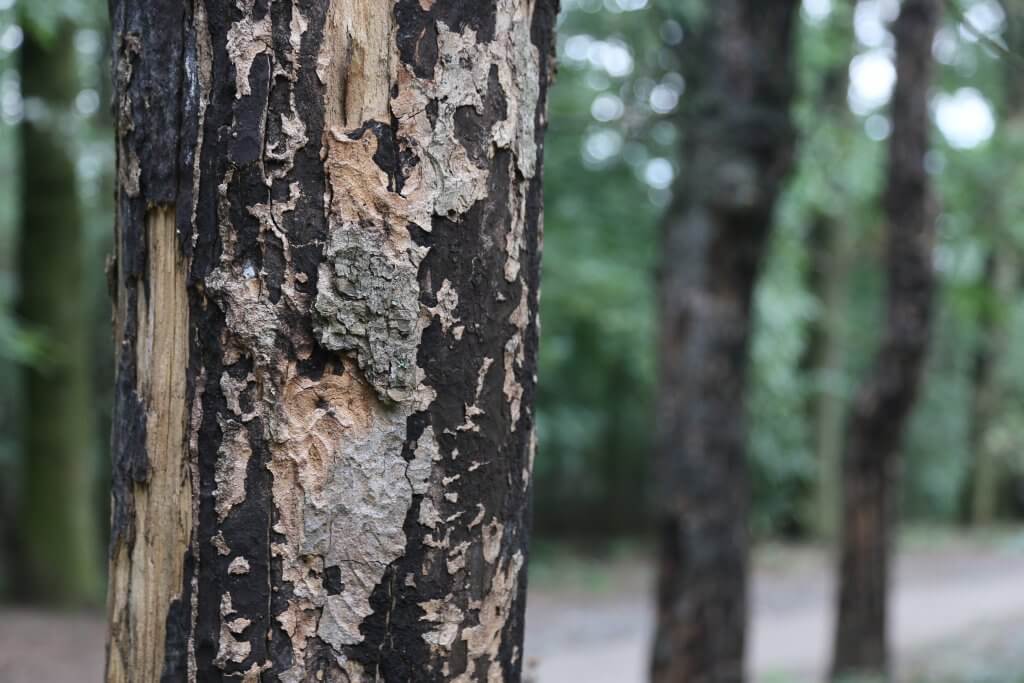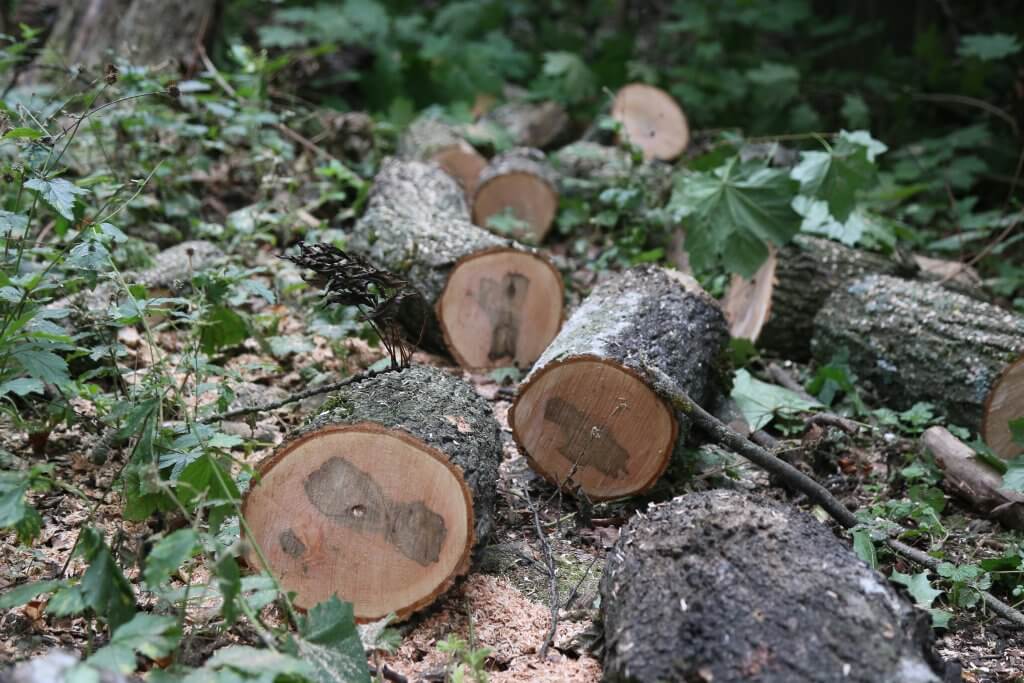Sooty bark disease in Maples is caused by the fungus Cryptostroma corticale. The Sycamore is particularly susceptible. The fungus was apparently introduced to Europe after World War II from the Great Lakes region of North America. For many decades, phytopathologists were hardly aware of it. In the last 20 years, however, it has spread practically throughout Europe. Climate change is believed to be to blame, as the disease thrives especially in hot, dry summers. Scientists from the Department of Forest Conservation and Wildlife Management at FFWT MENDELU, together with their European colleagues, used pollen monitoring samples to detect the movement of spores of this pathogen across Europe. Spores are capable of spreading hundreds of kilometres through the air.
The fungus Cryptostroma corticale, which causes the sooty disease in maple bark, thrives best in dry months with a lack of rainfall and at an average temperature of around 25 °C. In such conditions, the trees are stressed and weakened, ideal conditions for the fungus to develop: “The fungus begins to propagate and also become visible. However, it can live in the tree for many years before it is visible. It grows through the middle of the tree trunk, emerging when the time is right, into the bark layer. Within the bark, the fungus creates a reproductive body, a black mass, up to a metre wide called the stroma, which is revealed when the outer bark is broken off due to the growth of the stroma itself. At this moment, we can observe the most typical symptom of the presence of this fungus, a layer of black-brown soot – gender-neutral fungal spores, which, as we have found, can travel hundreds of kilometres thanks to air streams,” explains Miloň Dvořák from the Department of Forest Conservation and Wildlife Management.
Airborne spores can easily infect other trees through any exposed areas of wood. However, inhalation of spores can also be dangerous to humans: “They probably won’t harm a healthy person, but they can cause hypersensitivity pneumonitis in sensitive people. If left untreated, this can even cause death. Such cases were already recorded in the 1940s in North America, where the fungus was first identified. To this day, this disease is known as “maple bark peeler’s lung” and is also listed in the International Classification of Diseases,” says Dvořák, speaking of the health risks.
Scientists from FFWT MENDELU, together with colleagues from France, Switzerland, Italy, Portugal and Sweden, established cooperation in their home countries with state pollen services united under the banner of the European Aeroallergen Network (EAN). Their aim was to find out if it is possible to monitor the spread of spores of C. corticale fungus by analysis of commonly collected pollen samples. “Thanks to the willingness of the staff of these institutions, we managed to obtain samples of daily pollen captures from June to September 2018. We decided not to look for spores with a microscope, like EAN, but by isolating all DNA and then using the real-time PCR method, which needs no explanation since the covid era. However, it was not easy to isolate sufficient DNA, the samples were several years old, stored somewhere in cabinets. Moreover, they are fixed with a special solution between microscope slides, and on top of that they are stained with chemicals that can interfere with the course of the PCR reaction,” explains the researcher, on the pitfalls of sample processing.
Despite these problems, laboratory diagnostics confirmed the occurrence of C. corticale across the European continent, specifically in countries where sooty maple bark disease is currently observed, i.e. in the Czech Republic, France, Switzerland and Italy.


However, a number of questions remain unanswered for the time being, and will be the subject of further research. “Recognizing this pathogen is all the more difficult because a similar black mass of spores that can be found under the bark of maples is also produced by other fungi, but these colonize purely dead maples. Perhaps this is also the reason why this fungus has been overlooked by the scientific community for some time. We thought that the black mass was something we had known for a long time, and that it was a so-called saprophyte which occurs when the maple tree dies. There is, however, one difference, the spore mass of sooty maple bark disease is not pure black, but black-brown, it forms thicker layers of stroma than other fungi, and releases the mass into the air upon contact. All it takes is a gust of wind and a dark cloud rises from the tree,” adds Dvořák.
But it turns out that sooty maple bark disease is not only a European problem. A study trip to the west coast of the USA confirmed the occurrence of the fungus, in addition to newly reported occurrences in the states of Washington and California, as well as in Oregon. Dvořák is currently working on the development of a spore catcher: “My colleagues in Oregon and I agreed that I would try to build a cheap, small, but tailor-made spore catcher for this fungus that would allow us to monitor the spread of the fungus.” In order for monitoring to make sense, the traps must be placed over a large area, and since one standard volumetric trap used by EAN costs over 100,000 CZK, we agreed on this procedure,” explains Dvořák, an expert on fungus detection in the air.
In terms of practice, the question is whether it is possible to protect maples from the fungal pathogen C. corticale in some way: “The only thing we can do is to spread information. To teach those who are in daily contact with trees, foresters, managers of urban greenery, to prevent damage to maple trunks, because this fungus enters the tree through mechanical damage to the bark. The disease is detected mainly in maples growing in cities. This is where the trees are damaged the most, for example as a result of insensitive pruning, or on the other hand, in completely derelict brownfield sites, where maples spontaneously rejuvenate and compete aggressively for the available moisture in overgrown stands,” concludes the researcher.
Contact for further information: doc. Ing. Miloň Dvořák, Ph.D., Department of Forest Conservation and Wildlife Management FFWT MENDELU +420 775 680 314, e-mail: milon.dvorak@mendelu.cz
The research was supported under the HORIZON 2020 programme, grant no. 771271 “HOlistic Management of Emergent forest pests and Diseases” (HOMED).
More news
-
For two decades, the Czech Liaison Office for Education and Research in Brussels (CZELO) has been supporting Czech institutions, researchers, and students in engaging with European programmes in education, science, and innovation. At the…9. 10. 2025
-
Scientific expedition in Mongolia: new butterfly discoveries and warning signs…
Experts from Mendel University, in collaboration with colleagues from other scientific institutions, conducted biodiversity mapping during a three-week summer stay in Mongolia, focusing on the southwestern part of the country, the Gobi Altai region…28. 8. 2025 -
Coffee cultivation has a poor future due to climate change, agroforestry system…
Globally, coffee provides a livelihood for 125 million people. But forecasting models show that its cultivation has a poor future due to climate change. Sites suitable for growing Coffea arabica are predicted to decline dramatically. In that case,…4. 8. 2025 -
A new publication on biodiversity of the floodplain landscape in the…
Ecological Changes and Biodiversity of the Floodplain Landscape in the Morava–Dyje Confluence Area is the title of a book that will be published in the second half of 2025. It is the result of the work of a broad spectrum of experts specializing in…28. 7. 2025 -
EuAsiaN-ROOT Project Unveils Collaborative Research on Tree-Root-Mycorrhizal…
The Horizon Europe project, Eurasian Network for Collaborative Research on Tree-Root-Mycorrhizal-Pathogen Interactions in Forest Soils (EuAsiaN-ROOT), coordinated by the Faculty of Forestry and Wood Technology, aims to provide a deeper…24. 6. 2025 -
Five Female Wolves Fitted with GPS Collars in the Beskydy and Javorníky…
Researchers from the Faculty of Forestry and Wood Technology at Mendel University in Brno have successfully captured and fitted GPS telemetry collars on five female wolves in the Beskydy and Javorníky Mountains over the past two years. These…28. 5. 2025 -
FFWT launches unique data collection on forest ecosystem functioning in MENDELU…
The Department of Forest Ecology at the Faculty of Forestry and Wood Technology of Mendel University in Brno (FFWT MENDELU), in cooperation with the Masaryk Forest Training Enterprise at Křtiny (ŠLP Křtiny), has launched monitoring of selected…23. 5. 2025 -
Professor Vladimír Tesař on the 30th anniversary of Pro Silva Bohemica: focus…
The Faculty of Forestry and Wood Technology and other stakeholders commemorated the thirtieth anniversary of Pro Silva Bohemica, an association of foresters dedicated to promoting close-to-nature forest management. Professor Emeritus Vladimír Tesař…9. 5. 2025 -
Scientists aim to determine which tree species have the most significant…
An international team studying the growth of 223 tree species across 160 experimental forests worldwide has found that conservative tree species—efficiently conserving resources such as nutrients, water, and energy—tend to grow faster under natural…16. 4. 2025 -
FFWT and UFE Křtiny partners of the ForDiL project supporting the education of…
The Faculty of Forestry and Wood Technology, Mendel University (FFWT MENDELU) and the University Forest Enterprise Masaryk Forest Křtiny (UFE Křtiny) are the main partners of the ERASMUS+ project Forest of the future: digital tools for learners to…11. 4. 2025